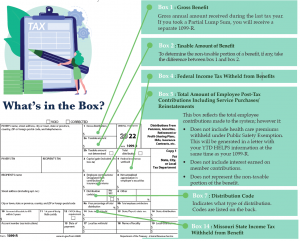Taxes and 1099-Rs
Your LAGERS retirement benefit is subject to all applicable State and Federal taxes. LAGERS will withhold taxes from your retirement benefit as directed by you. It is important to keep in mind that regardless of how much you withhold, you are responsible for any tax liability each year.
Retiree Federal Tax Withholding Form
What is Taxable?
- The portion of your benefit funded through employer contributions and investment returns
- Interest earnings on your employee contribution account
What is Not Taxable?
- If you have employee contributions with LAGERS. These contributions were made on an after-tax basis and are not taxable at the time of withdrawal.
Partial Lump Sum Option (PLUS)
A retiree does have the option to directly roll over the entire PLUS amount to another qualified retirement account to delay any tax implications. If you elect this option, LAGERS will send you a direct rollover form during your application process.
If you elect to take the Partial Lump Sum Option, that lump sum is also subject to all applicable state and federal taxes. LAGERS will automatically withhold 20% and forward to the IRS if the PLUS is disbursed directly to you. Please keep in mind that your actual tax liability may be more or less than 20%.
You may also be subject to an early distribution penalty when receiving the Partial Lump Sum directly:
- General Employee: If you receive the payment prior to attaining age 55.
- Public Safety: If you receive the payment prior to attaining 25 years of considerable public safety service or age 50.
You may also be subject to early distribution penalties, if you receive the payment before attaining age 55 if you are a general employee and age 50 if you are a public safety employee.
A retiree does have the option to directly roll over the entire PLUS amount to another qualified retirement account to delay any tax implications. If you elect this option, LAGERS will send you a direct rollover form during your application process.

LAGERS will withhold taxes from your monthly benefit for Federal and Missouri income taxes only. The amount withheld from your benefit is at your direction and can be changed at any time. To adjust your current withholding, you can either complete LAGERS Tax Withholding form and submit it to the LAGERS office OR log on to the myLAGERS member web portal.
The contents of this page are not intended to and should not be considered tax advice. LAGERS staff is not qualified to give such advice. This information does not amend or overrule any applicable statute or administrative rule. In the event of conflict, the applicable statute or administrative rule will prevail. If you have questions regarding your specific tax situation, please contact a qualified tax professional.
Depending on a number of factors, you may be able to deduct up to 100% of your public retirement benefits from your Missouri income tax. Starting with the 2024 tax year, this exemption is no longer limited by your filing status or adjusted gross income. (Previously, married couples with Missouri adjusted gross income less than $100,000 and single individuals with Missouri adjusted gross income less than $85,000, could deduct up to 100 percent of their public retirement benefits, to the extent the amounts were included in their federal adjusted gross income.)
The total public pension exemption is limited to the maximum social security benefit of each spouse.
Missouri also offers a similar exemption for Social Security and Social Security disability benefits. If you also qualify for a Social Security exemption, it may impact your public pension exemption.
If you are enlisting a tax preparer or tax advisor to complete your taxes, be sure to refer them to RSMO 143.124 for the proper administration of your tax withholdings.
Visit https://dor.mo.gov/faq/taxation/individual/pension-tax-year-2024.html for more information or contact a qualified tax professional.
Public safety retirees may qualify for a $3,000 federal income tax deduction for health and long term care premiums.
Federal regulations allow for a reduction in your federal taxable income in connection with premiums for various types of insurance if you qualify. In order to qualify you must have:
- Been serving as a public safety officer (as defined by applicable federal law) when you retired.
- Retired under the normal retirement provision of the system (meaning that you did not take an early retirement) or you must have taken a disability retirement. Rule of 80 qualified retirement does qualify.
The definition of eligible public safety officers is included in federal law (42 U.S.C. 3796b(9)). Generally, they are individuals who served a public agency in one of the following official capacities:
- An individual involved in crime and juvenile delinquency control or reduction, or enforcement of the criminal laws (including juvenile delinquency), including, but not limited to police, corrections, probation, parole, and judicial officers
- Professional firefighter
- Officially recognized or designated public employee members of a rescue squad or ambulance crew
- Chaplains serving in a police or fire department.


